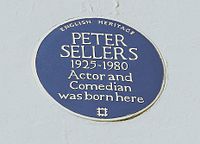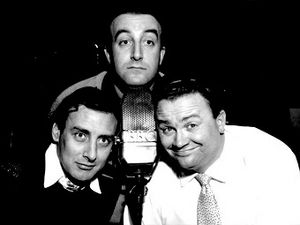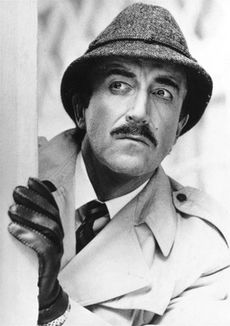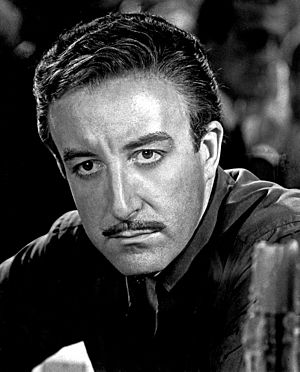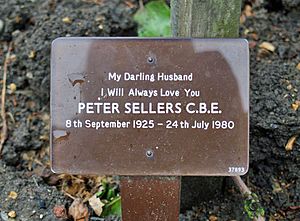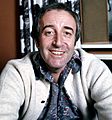Peter Sellers facts for kids
Quick facts for kids
Peter Sellers
|
|
|---|---|
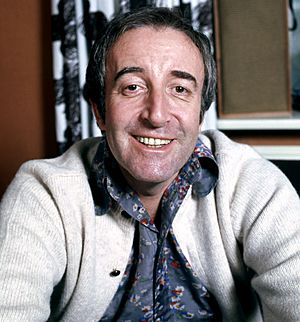
Sellers in 1973
|
|
| Born | 8 September 1925 Portsmouth, England
|
| Died | 24 July 1980 (aged 54) London, England
|
| Occupation |
|
| Years active | 1925–1980 |
|
Works
|
Full list |
| Spouse(s) |
Anne Howe
(m. 1951; div. 1963)Miranda Quarry
(m. 1970; div. 1976)Lynne Frederick
(m. 1977) |
| Children | 3; including Michael and Victoria |
Peter Sellers CBE (born Richard Henry Sellers; 8 September 1925 – 24 July 1980) was a famous English actor and comedian. He became well-known for his work on the BBC Radio comedy show The Goon Show. He also had many hit comedy songs. People all over the world knew him from his movie roles, especially as Chief Inspector Clouseau in The Pink Panther movies.
Peter Sellers was born in Southsea, Portsmouth. He first appeared on stage when he was just two weeks old! He toured with his parents, who were also entertainers. He started as a drummer and later joined the Entertainments National Service Association (ENSA), which provided entertainment for soldiers. During this time, he became very good at imitating voices and making things up on the spot. After the war, he started working on BBC radio shows. In the early 1950s, Sellers, along with Spike Milligan, Harry Secombe, and Michael Bentine, created The Goon Show, which was very popular until 1960.
Sellers began his movie career in the 1950s. Most of his roles were funny, often making fun of people in charge like police officers. But he also acted in other types of movies. Some of his famous films include I'm All Right Jack (1959), Stanley Kubrick's Lolita (1962) and Dr. Strangelove (1964), The Party (1968), Being There (1979), and five Pink Panther movies (1963–1978). Peter Sellers was very good at playing many different characters. He could use various accents and disguises, often playing several roles in the same movie. Many of his films used satire (making fun of things to show their flaws) and black comedy (humor about dark topics). These styles influenced many comedians who came after him. Sellers was nominated for an Academy Award three times. He won the BAFTA Award for Best Actor in a Leading Role twice. In 1980, he won a Golden Globe Award for Best Actor – Motion Picture Musical or Comedy for his role in Being There. Turner Classic Movies called him "one of the most accomplished comic actors of the late 20th century."
In his personal life, Sellers sometimes felt unsure of himself. He was married four times and had three children. He died from a heart attack at age 54 in 1980. The English filmmakers, the Boulting brothers, said Sellers was "the greatest comic genius this country has produced since Charles Chaplin."
Contents
Early Life and Career
Growing Up (1925–1935)
Peter Sellers was born on 8 September 1925, in Southsea, near Portsmouth. His parents, William "Bill" Sellers and Agnes Doreen "Peg" (née Marks), were both entertainers. They called him Peter after his older brother who had passed away. Peter was an only child. His mother, Peg, was related to the famous boxer Daniel Mendoza, whom Sellers admired.
When he was just two weeks old, Peter was carried onto the stage at the Kings Theatre, Southsea. The audience sang "For He's a Jolly Good Fellow," which made the baby cry! His family traveled a lot for their acts, which made Peter's early life a bit unsettled.
Peter had a very close relationship with his mother. His friend Spike Milligan thought it was an unusual bond for an adult. Peter was a shy young man, and his mother often made decisions for him. Because he was an only child, he spent a lot of time by himself.
In 1935, his family moved to North London. Even though his father was Protestant and his mother was Jewish, Peter went to a Roman Catholic school called St Aloysius' College, Highgate. His family wasn't rich, but his mother wanted him to have a good private education. Peter was interested in religion from a young age. He became a top student, especially good at drawing. He was sometimes lazy, but his natural talent helped him avoid trouble with his teachers.
First Performances (1935–1939)
Peter learned about performing by traveling with his family's variety show. His parents gave him different advice. His father doubted his acting skills, but his mother always encouraged him.
At St Aloysius College, Peter started to practice making up characters and dialogue. He and his friend Bryan Connon loved listening to radio comedy shows. Peter was great at imitating radio personalities and creating his own voices.
World War II (1939–1945)
When World War II began, Peter's school moved away from London. His mother didn't let him go, so his formal schooling ended when he was fourteen. In 1940, his family moved to Ilfracombe, where his uncle managed the Victoria Palace Theatre. Peter got his first job there at age fifteen, starting as a caretaker. He was promoted to box office clerk, usher, and even got small acting parts. Working backstage allowed him to watch and learn from actors.
Peter also started playing the drums. He practiced on a set belonging to a band called Joe Daniels and his Hot Shots. Joe Daniels taught him. Peter became very good at drumming, and some thought he might have become a jazz drummer if he hadn't been so talented at acting and comedy. As the war continued, Peter played with several touring bands. He also joined the Entertainments National Service Association (ENSA), which entertained British soldiers. He performed comedy routines, including impressions of George Formby.
In 1943, he joined the Royal Air Force. He wanted to be a pilot, but his eyesight meant he had to work on the ground. He found this boring, so he auditioned for the RAF Gang Show entertainment group. He toured the UK and then went to India, Ceylon, and Burma. He also served in Germany and France after the war. A friend, David Lodge, said Peter was an amazing drummer and could perfectly imitate military officers.
Starting His Career and The Goon Show (1946–1955)
In 1946, Peter performed in his last ENSA show, a play called Jack and the Beanstalk in Paris. He then returned to England and left the RAF. At first, he found it hard to get steady acting work. He was even fired from one show, but the main singer, Dorothy Squires, helped him get his job back. He continued drumming and was even called "Britain's answer to Gene Krupa" (a famous drummer). In 1948, he performed for six weeks at the Windmill Theatre in London, known for its variety acts.
Sellers wrote to the BBC in 1948 and soon made his television debut. His act, mostly impressions, was popular. He even tricked a BBC radio producer into giving him an audition by pretending to be a famous radio star! This led to more radio work. By late 1948, Peter was a regular on several BBC radio shows.
By the end of 1948, Peter, Harry Secombe, and Michael Bentine were in a comedy series called Third Division. One night, Peter and Bentine met Spike Milligan. The four comedians often met at a pub and became known as the "Goons."
In 1949, Peter started dating Anne Howe, an Australian actress. They married in 1951. Their son, Michael, was born in 1954, and their daughter, Sarah, in 1958. Peter's first movie work was in 1950, where he did voice-overs for a film. He kept working with Bentine, Milligan, and Secombe. In 1951, they made a trial recording called The Goons, which the BBC accepted.
The first Goon Show was broadcast on 28 May 1951. It became incredibly popular, reaching seven million listeners in Britain. Many people called it "probably the most influential comedy show of all time." For Peter, it launched his career to stardom. He played four main characters and seventeen smaller ones in the show, which ran until 1960.
In 1951, the Goons also made their first movie, Penny Points to Paradise. Peter and Milligan wrote another film, Let's Go Crazy, which showed Peter's talent for playing many different characters in one movie. In 1954, Peter got a bigger role in the comedy Orders Are Orders. Many believe this film helped launch his and Tony Hancock's movie careers.
Early Film Success (1956–1959)
Peter continued his film career with small roles, like a police officer in John and Julie (1955). He got a more important part in the 1955 comedy The Ladykillers, where he acted alongside his hero, Alec Guinness. Peter played Harry Robinson, a "Teddy Boy" (a youth subculture). This film was a success in both the UK and the US. The next year, Peter appeared in three TV shows based on The Goons. In 1957, he played a 68-year-old projectionist in The Smallest Show on Earth, which was also a commercial success. He also provided the voice of Winston Churchill for the film The Man Who Never Was. Later in 1957, Peter played a TV star who was good at disguises in the comedy The Naked Truth.
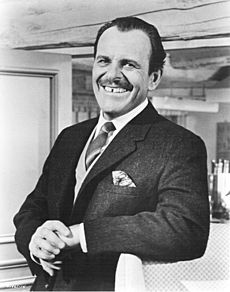
Peter sometimes struggled with his film career and personal life. He often sought advice from an astrologer. He also believed that the old music hall comedian Dan Leno (who died in 1904) haunted him and guided his decisions. In 1958, Peter starred as a chief petty officer in Up the Creek. The director said he wrote the film especially for Peter. Peter bought a tape recorder to practice his voices. This film was important for Peter's acting practice. Next, he appeared with Terry-Thomas in Tom Thumb (1958), a musical fantasy film. This was Peter's first contact with the Hollywood film industry.
Peter released his first comedy album, The Best of Sellers, in 1958. It included funny songs and sketches and reached number three on the UK Albums Chart. The same year, he appeared in Carlton-Browne of the F.O.. Before that film was released, he started filming I'm All Right Jack, which became the highest-grossing film in Britain in 1960. For his role as Fred Kite, Peter studied union officials. He won a BAFTA award for this role. Peter also starred in The Mouse That Roared, playing three different main roles: an old Grand Duchess, a Prime Minister, and a clumsy farm boy. Critics praised his performance.
After I'm All Right Jack, Peter recorded a new series of The Goon Show. He also filmed an eleven-minute short film called The Running Jumping & Standing Still Film with his friends. It won an award at the San Francisco film festival and was nominated for an Academy Award. In 1959, Peter released his second album, Songs for Swingin' Sellers, which also reached number three in the UK. His last film of the 1950s was The Battle of the Sexes.
Major Film Roles
The Millionairess, Lolita, The Pink Panther (1960–1963)
In 1960, Peter played an Indian doctor in the romantic comedy The Millionairess. He wasn't interested in the role until he found out Sophia Loren would be his co-star. The film led to a hit song, "Goodness Gracious Me," which Peter sang with Sophia Loren. They also released an album together. That year, he also played a serious villain in Never Let Go (1960).
In 1961, Peter directed his first film, Mr. Topaze, in which he also starred. The film and his directing skills didn't get good reviews, and Peter rarely talked about it again. The same year, he starred in Only Two Can Play, for which he was nominated for a BAFTA award.
In 1962, Peter played a retired British army general in Waltz of the Toreadors. He won an award at the San Sebastián International Film Festival and a BAFTA nomination for his acting. Stanley Kubrick then asked Peter to play Clare Quilty in the 1962 film Lolita. Kubrick was impressed by Peter's ability to play many different characters. Peter later said his relationship with Kubrick was one of the best of his career. In late 1962, Peter also appeared in The Dock Brief.
Peter's marriage to Anne ended in 1962. In 1963, he starred in The Wrong Arm of the Law and then played a vicar in Heavens Above!
After his father passed away in 1962, Peter decided to leave England. Director Blake Edwards offered him the role of Inspector Clouseau in The Pink Panther. Peter accepted the role. The film also starred David Niven. Even though other actors had bigger roles, Peter's performance as Clouseau was seen as amazing, like those of Charlie Chaplin. Peter created the character's personality, including his costume, accent, and mustache.
The Pink Panther was released in 1964 and was a big success, becoming one of the top ten highest-grossing films of the year. Peter's role earned him nominations for a Golden Globe and a BAFTA award.
Dr. Strangelove, Health, and Second Marriage (1964–1969)
In 1963, Stanley Kubrick cast Peter in Dr. Strangelove or: How I Learned to Stop Worrying and Love the Bomb. Peter and Kubrick got along very well. Kubrick asked Peter to play three roles: US President Merkin Muffley, Dr. Strangelove, and Group Captain Lionel Mandrake. Peter was unsure at first, but Kubrick convinced him. Kubrick wanted Peter in many key roles because "everywhere you turn there is some version of Peter Sellers holding the fate of the world in his hands." Peter was worried about doing a good Texan accent for one role, but he practiced and got it right.
During filming, Peter sprained his ankle and couldn't work in the small airplane set. So, another actor took over one of his roles. The three roles Peter did play were very different and showed his amazing talent. Critics praised his performances. For these roles, Peter was nominated for an Academy Award for Best Actor and a BAFTA award.
Between 1963 and 1964, Peter filmed A Shot in the Dark. He didn't like the director, so the producers brought in Blake Edwards. They changed the script to be a Clouseau comedy, adding Herbert Lom as Commissioner Dreyfus and Burt Kwouk as Cato. During filming, Peter and Edwards sometimes had disagreements. Peter was known for being difficult at times and often clashed with others. Despite this, the film was a success.
In February 1964, Peter met Britt Ekland, a Swedish actress. They married just ten days later! Soon after, Peter started filming Kiss Me, Stupid. However, he suffered several heart attacks and had to leave the film. Another actor replaced him.
After recovering, Peter returned to filming in October 1964. He played the King of the Individualists alongside Britt Ekland in A Carol for Another Christmas. He was worried his heart attacks might have affected his memory, but he found he could still remember his lines. Next, Peter appeared in What's New Pussycat? with Peter O'Toole and Ursula Andress. This was the first film written by and starring Woody Allen.
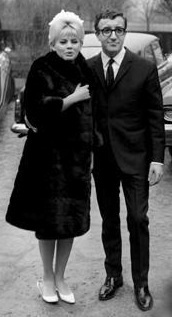
In January 1965, Peter and Britt had a daughter, Victoria. They moved to Rome to film After the Fox. Peter had disagreements with the director and even with Britt's acting, which caused tension.
After the success of What's New Pussycat?, Peter and Woody Allen worked together again on Casino Royale, which also starred Orson Welles. Peter signed a $1 million contract for the film. Filming was difficult, and Peter and Welles did not get along. Peter even demanded they not be on the same set. Peter left the film before his part was finished.
Soon after, Peter was honored with the title of Commander of the Most Excellent Order of the British Empire (CBE) for his achievements. While filming The Bobo, Peter's mother had a heart attack. She passed away a few days later, and Peter was deeply affected by her death. Britt Ekland filed for divorce soon after, which was finalized in 1968. The Bobo did not do well.
Peter's first film in 1968 was a reunion with Blake Edwards for The Party. He played Hrundi V. Bakshi, a clumsy Indian actor who accidentally gets invited to a Hollywood party. This character was a mix of Clouseau and his doctor role in The Millionairess. Peter played him in a kind and dignified way. Later that year, he starred in I Love You, Alice B. Toklas, playing a lawyer who becomes a hippie.
In 1969, Peter starred with Ringo Starr in The Magic Christian. Peter played Sir Guy Grand, a rich man who plays elaborate jokes on people. The film was a satire about human nature and received mixed reviews.
Later Films and Personal Life (1970–1978)
After a small role in A Day at the Beach (1970) and a serious role in Hoffman (1970), Peter starred in There's a Girl in My Soup with Goldie Hawn. This film was a big commercial success and helped revive his career.
Peter's next films, like Where Does It Hurt? (1972) and Ghost in the Noonday Sun (1974), were not well-received. However, he won the Best Actor award at the 1973 Tehran Film Festival for his role in The Optimists of Nine Elms. His friend Spike Milligan felt that the early 1970s were a difficult time for Peter's career. In his private life, Peter married Miranda Quarry in 1970.
In April 1972, Peter reunited with Milligan and Harry Secombe for The Last Goon Show of All. In 1973, his third marriage was ending, and Peter became engaged to Liza Minnelli for a short time. By 1974, Peter's friends were worried about him. He was described as a "deeply troubled man." Peter was often shy and insecure when not playing a character. When invited to a TV chat show in 1974, he refused to appear as himself. Instead, he came dressed as a member of the Gestapo before finally relaxing and being brilliant. In 1974, Peter again said he communicated with the old comedian Dan Leno, who advised him to return to playing Clouseau.
In 1974, Peter played Queen Victoria in The Great McGonagall, which was not a success. His career was at a low point. He started appearing in TV commercials, playing different funny characters.
A turning point came in 1974 when he worked with Blake Edwards again on The Return of the Pink Panther. The film was a huge success, earning $33 million and bringing Peter back to being a top film star. He was nominated for a Golden Globe award. In 1976, he made The Pink Panther Strikes Again. During filming, Peter and Blake Edwards had many disagreements. Despite Peter's personal challenges, the film was very popular. Critics praised Peter's performance. He earned another Golden Globe nomination.
In March 1976, Peter started dating actress Lynne Frederick, and they married in 1977. In March 1977, Peter had another major heart attack and had a pacemaker fitted. After recovering, he filmed Revenge of the Pink Panther. Although it was a commercial success, critics felt the Inspector Clouseau character was getting old. Peter himself said he was tired of the role. Peter sometimes struggled with his emotions and refused to seek professional help. He often said he felt like he had no personality of his own and needed a strong character to play. When he appeared on The Muppet Show in 1978, he chose not to appear as himself, instead using various costumes and accents.
Being There and Final Years (1979–1980)
In 1979, Peter starred in The Prisoner of Zenda, playing three roles, including two kings and a half-brother. The film was well-received, with critics noting his serious performance.
Later in 1979, Peter starred in the black comedy Being There as Chance, a simple gardener who is seen as very wise by powerful people. During filming, Peter stayed in character and avoided interviews. His performance was highly praised by critics and is considered a highlight of his career. He won several awards for this role, including a Golden Globe, and was nominated for an Academy Award.
In March 1980, Peter asked his 15-year-old daughter Victoria what she thought of Being There. When she said he looked like a "little fat old man," he became very angry. He later sent his other daughter, Sarah, a harsh telegram.
Peter's last film was The Fiendish Plot of Dr. Fu Manchu, a comedy based on adventure novels. Peter played both police inspector Nayland Smith and Fu Manchu. The film had many problems during production, and Peter even took over directing some parts. Critics generally did not like the film.
Peter's final performances were a series of advertisements for Barclays Bank. He played a character called Monty Casino. He filmed three ads before collapsing in Dublin with more heart problems. Against medical advice, he traveled to the Cannes Film Festival. He became ill again and returned home to work on a script for a new Pink Panther movie. His fourth marriage to Lynne Frederick also ended around this time.
Peter had recently started to improve his relationship with his son Michael. He used to joke that his tombstone should say "Star of stage, screen and alimony."
Death and Legacy
On 21 July 1980, Peter Sellers arrived in London. He checked into a hotel and visited Golders Green Crematorium to see where his parents' ashes were. He had plans to meet his Goon Show friends, Milligan and Secombe, for dinner on 22 July. On that day, Peter had lunch in his hotel suite and then collapsed from a heart attack. He was taken to the Middlesex Hospital, London, and passed away just after midnight on 24 July 1980, at age 54.
After Peter's death, actor Richard Attenborough said Peter "had the genius comparable to Chaplin." The Boulting brothers called him "the greatest comic genius this country has produced since Charles Chaplin." Burt Kwouk, who played Cato in the Pink Panther films, said that when Peter died, "it seemed that the whole country came to a stop." Blake Edwards thought Peter was "brilliant" and great at finding unique parts of characters. Spike Milligan was too sad to speak to the press. Harry Secombe said, "I'm shattered. Peter was such a tremendous artist." He also joked about the missed dinner, saying, "Anything to avoid paying for dinner."
A private funeral was held at Golders Green Crematorium on 26 July. Peter's final joke was having the song "In the Mood" by Glenn Miller played, a tune all the Goons disliked. A memorial service was held on 8 September 1980, what would have been his 55th birthday.
Even though Peter was reportedly changing his will to exclude Lynne Frederick a week before he died, she inherited almost his entire estate, worth about £4.5 million. His children received only £800 each. Spike Milligan asked Lynne to give more to the children, but she refused. Peter's only son, Michael, died of a heart attack at age 52 on 24 July 2006, exactly twenty-six years after his father's death.
After Peter's death, the studio tried to continue the Pink Panther series. In 1982, Blake Edwards released Trail of the Pink Panther, which used old scenes of Peter from previous Panther films. Lynne Frederick sued, saying this was a breach of contract, and she won a large sum of money.
Influence and Legacy
New York magazine said that all of Peter Sellers's films as Clouseau showed his "comedic brilliance." Spike Milligan said Peter "had one of the most glittering comic talents of his age." He was a "chameleon" who could change his appearance and voice, dazzling audiences. In a 2005 poll, Peter Sellers was voted 14th in a list of the top 20 greatest comedians by other comedians.
Peter Sellers and The Goon Show greatly influenced the Monty Python comedians. John Cleese called him "the greatest voice man of all time." The Goons also influenced the American comedy group the Firesign Theatre.
Many other comedians and actors have said Peter Sellers influenced them, including Peter Cook, Mike Myers, Alan Carr, Rob Brydon, Rowan Atkinson (for his Mr. Bean and Johnny English characters), Sacha Baron Cohen, Will Ferrell, and the members of Spinal Tap. David Schwimmer said Peter "could do anything, from Dr Strangelove to Inspector Clouseau. He was just amazing."
As a child, Eddie Murphy learned to play multiple characters by imitating Peter Sellers, whom he called his acting hero. Chris Rock even described Murphy's multi-character performances as "Peter Sellers-esque." Robin Williams also said Peter was an important influence, especially his multi-character roles in Dr. Strangelove. Eddie Izzard noted that the Goons influenced a new generation of comedians.
In 1998, a stage play called Being Sellers premiered in Australia. In 2004, a book about Peter's life was made into an HBO film called The Life and Death of Peter Sellers, starring Geoffrey Rush.
Selected Films and Awards
| Film | Year | Role | Award |
|---|---|---|---|
| The Running Jumping & Standing Still Film | 1959 | Nominated – Academy Award for Short Subject (Live Action) | |
| I'm All Right Jack | 1959 | Fred Kite | Won – British Academy Film Award for Best British Actor |
| Waltz of the Toreadors | 1962 | General Leo Fitzjohn | Won – San Sebastián International Film Festival for Best Actor |
| Lolita | 1962 | Clare Quilty | Nominated – Golden Globe Award for Best Supporting Actor |
| Only Two Can Play | 1962 | John Lewis | Nominated – British Academy Film Award for Best British Actor |
| The Pink Panther | 1963 | Inspector Jacques Clouseau | Nominated – Golden Globe Award for Best Actor – Musical or Comedy Nominated – British Academy Film Award for Best British Actor |
| Dr. Strangelove | 1964 | Group Captain Lionel Mandrake/ President Merkin Muffley/ Dr. Strangelove |
Nominated – Academy Award for Best Actor Nominated – British Academy Film Award for Best British Actor |
| The Optimists of Nine Elms | 1973 | Sam | Won – Tehran Film Festival Award for Best Actor |
| The Return of the Pink Panther | 1975 | Inspector Jacques Clouseau | Won – The Evening News British Film Award for Best Actor Nominated – Golden Globe Award for Best Actor – Musical or Comedy |
| The Pink Panther Strikes Again | 1976 | Inspector Jacques Clouseau | Nominated – Golden Globe Award for Best Actor – Musical or Comedy |
| Being There | 1979 | Chance | Won – National Board of Review Award for Best Actor Won – New York Film Critics Circle Award for Best Actor Won – Golden Globe Award for Best Actor – Musical or Comedy Won – London Film Critics Circle Award for Best Actor Nominated – British Academy Film Award for Best Actor in a Leading Role Nominated – Academy Award for Best Actor |
Images for kids
See also
 In Spanish: Peter Sellers para niños
In Spanish: Peter Sellers para niños


